 Bone broth is definitely a healing food, but there’s also lots of myths about broth, so let’s review all the what’s, why’s, and how’s!
Bone broth is definitely a healing food, but there’s also lots of myths about broth, so let’s review all the what’s, why’s, and how’s!
Table of Contents[Hide][Show]
The reason why bone broth is so beneficial is that it’s a super valuable source of collagen protein! Collagen is the most abundant protein in our bodies, accounting for approximately 30% of all our proteins, and is our dominant structural protein, including being a main building block of connective and interstitial tissues, bone, cartilage, ligaments, tendons, and skin. It’s also abundant in muscles, blood vessels, corneas, and teeth. But, normal aging, chronic inflammation, chronic stress, nutritional deficiencies, UV radiation, and smoking can all decrease collagen production as well as degrade collagen structure. This leads not only to wrinkles, but osteopenia and osteoporosis, osteoarthritis, cardiovascular disease and decreased organ function, including heart, lungs and kidneys! For a deep dive into the roles of collagen in human health, see Gelatin vs Collagen vs Bone Broth.
In fact, the amino acids in bone broth (especially glycine, proline and hydroxyproline but also arginine and glutamic acid) are ones that we tend to fall short on but that are essential for the health of our gut barriers (glutamine deficiency by itself causes a leaky gut), gut microbiomes (glutamine and arginine actually improve gut microbiome composition!), and immune systems (glycine is potently anti-inflammatory), not to mention connective and structural tissue all over the body (see 8 Nutrients for Leaky Gut, Why Broth is Awesome, The Role of Glutamine in Gut Health and make sure to check out The Gut Health Guidebook and The Paleo Approach).
The good news is that numerous studies have shown that consuming a mere 10 to 15 grams per day of collagen protein (about what you’d get in 1/2 to 1 cup of good quality bone broth) improves a variety of conditions related to bone, joint, tendon, skin, muscle, cardiovascular health and wound healing!
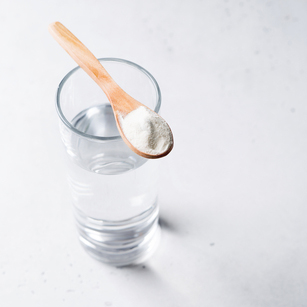 For example, a 2019 systematic review of eight studies showed that collagen hydrolysate supplementation at doses of 2.5 to 10 grams per day for 8 to 24 weeks showed measurable improvements in skin elasticity and moisture, as well as decreases in fine lines and wrinkles. A study of long-term care residents showed that pressure ulcers healed twice as fast in the group receiving a 15-gram collagen hydrolysate supplement three times daily for 8 weeks. A study of people with mild to moderate knee osteoarthritis showed that 10 grams of collagen hydrolysate daily over 24 weeks significantly improved a measure of cartilage quality while those receiving placebo saw a continued deterioration of cartilage. A study in athletes with activity-related joint pain showed that 10 grams daily of collagen hydrolysate for 24 weeks substantially reduced joint pain. Studies show that collagen supplements are effective in both elderly men and postmenopausal women at combatting sarcopenia. And in young athletes, studies show that 15-gram collagen peptides increases muscle mass and strength more than placebo after 12-weeks of strength training. And, in a study of postmenopausal women taking 5 grams of collagen peptides for a year, bone mineral density of both spine and femoral neck increased significantly compared to the placebo group. For way more detail and citations, see Gelatin vs Collagen vs Bone Broth.
For example, a 2019 systematic review of eight studies showed that collagen hydrolysate supplementation at doses of 2.5 to 10 grams per day for 8 to 24 weeks showed measurable improvements in skin elasticity and moisture, as well as decreases in fine lines and wrinkles. A study of long-term care residents showed that pressure ulcers healed twice as fast in the group receiving a 15-gram collagen hydrolysate supplement three times daily for 8 weeks. A study of people with mild to moderate knee osteoarthritis showed that 10 grams of collagen hydrolysate daily over 24 weeks significantly improved a measure of cartilage quality while those receiving placebo saw a continued deterioration of cartilage. A study in athletes with activity-related joint pain showed that 10 grams daily of collagen hydrolysate for 24 weeks substantially reduced joint pain. Studies show that collagen supplements are effective in both elderly men and postmenopausal women at combatting sarcopenia. And in young athletes, studies show that 15-gram collagen peptides increases muscle mass and strength more than placebo after 12-weeks of strength training. And, in a study of postmenopausal women taking 5 grams of collagen peptides for a year, bone mineral density of both spine and femoral neck increased significantly compared to the placebo group. For way more detail and citations, see Gelatin vs Collagen vs Bone Broth.
Bone broth is one of the richest sources of collagen protein, which is why it’s a foundational food for a nutrient-dense diet!
Why not just supplement with collagen hydrolysate or peptides like in the above-mentioned studies? Unfortunately, many (if not most) collagen supplements aren’t a good choice because of the way collagen manufacture has been industrialized in recent years. In addition, many collagen supplements now include wonky ingredients that can be problematic. I broke down all the science on why collagen the actual protein is amazing, why collagen the supplement is not, and why bone broth is the best choice for adding amazing collagen to our diets without the downsides of supplements in both Gelatin vs Collagen vs Bone Broth and The Whole View Podcast Episode 430: Collagen, Gelatin and Bone Broth, Oh My!
Busting 3 Bone Broth Myths
Despite wide acceptance of the health benefits of bone broth, there are some myths about this healing food that tend to make the rounds on the internet. So, let’s bust three of them (and confirm one!)
 Myth #1 – Bone Broth Contains More Calcium than Milk. While bone broth is an awesome source of collagen, it’s not actually a great source of minerals. In fact, studies have shown that even a long-simmered bone broth has a pretty underwhelming mineral content, which I explain in detail in Why Broth is Awesome
Myth #1 – Bone Broth Contains More Calcium than Milk. While bone broth is an awesome source of collagen, it’s not actually a great source of minerals. In fact, studies have shown that even a long-simmered bone broth has a pretty underwhelming mineral content, which I explain in detail in Why Broth is Awesome
 Myth #2 – Bone Broth Is Full of Heavy Metals. Studies have shown that the amount of lead in long-simmered bone broth is far below the Environmental Protection Agency’s safe upper limit for lead in drinking water and wouldn’t feasibly be high enough to cause harm. This is discussed in more detail in Broth: Hidden Dangers in a Healing Food?
Myth #2 – Bone Broth Is Full of Heavy Metals. Studies have shown that the amount of lead in long-simmered bone broth is far below the Environmental Protection Agency’s safe upper limit for lead in drinking water and wouldn’t feasibly be high enough to cause harm. This is discussed in more detail in Broth: Hidden Dangers in a Healing Food?
 Myth #3 – Bone Broth is Full of Free Glutamate. Analyses of the amino acid content of broth found that 8 ounces of broth contained about 1013 mg of glutamic acid, which is way less than many other foods (e.g., a filet of salmon contains 12,940 mg of glutamic acid and one roasted chicken breast contains 8620 mg). Plus, it’s unknown how much of that glutamic acid is actually free rather than bound—it’s only speculation that glutamate gets freed up in broth. In addition, the addition of vinegar to broth doesn’t change the acidity enough to make any difference in terms of bone demineralization or free glutamate formation. Go ahead and add vinegar to your homemade broth if you like the taste, and don’t bother otherwise. I explain why we don’t need to worry about glutamates in broth in much more detail in Broth: Hidden Dangers in a Healing Food?
Myth #3 – Bone Broth is Full of Free Glutamate. Analyses of the amino acid content of broth found that 8 ounces of broth contained about 1013 mg of glutamic acid, which is way less than many other foods (e.g., a filet of salmon contains 12,940 mg of glutamic acid and one roasted chicken breast contains 8620 mg). Plus, it’s unknown how much of that glutamic acid is actually free rather than bound—it’s only speculation that glutamate gets freed up in broth. In addition, the addition of vinegar to broth doesn’t change the acidity enough to make any difference in terms of bone demineralization or free glutamate formation. Go ahead and add vinegar to your homemade broth if you like the taste, and don’t bother otherwise. I explain why we don’t need to worry about glutamates in broth in much more detail in Broth: Hidden Dangers in a Healing Food?
 Not a Myth – Skim the Fat! There is one legit concern with bone broth though, and that’s the fat on the top. When we long-simmer bone broth in the presence of oxygen (so, any method other than a pressure cooker), the fats become highly oxidized. So, if you’re making homemade bone broth, it’s always best to skim the fat. My favorite method for doing this is to chill the broth in the fridge, after which it’s easy to scoop up the solidified or semi-solid fat from the top. You can learn more in Bone Broth Risks: Skim the Fat!
Not a Myth – Skim the Fat! There is one legit concern with bone broth though, and that’s the fat on the top. When we long-simmer bone broth in the presence of oxygen (so, any method other than a pressure cooker), the fats become highly oxidized. So, if you’re making homemade bone broth, it’s always best to skim the fat. My favorite method for doing this is to chill the broth in the fridge, after which it’s easy to scoop up the solidified or semi-solid fat from the top. You can learn more in Bone Broth Risks: Skim the Fat!
Nutrivore Weekly Serving Matrix
An easy-to-use and flexible weekly checklist
to help you maximize nutrient-density.
The Weekly Serving Matrix is very helpful! I’ve been eating along these lines but this really helps me know where to focus vs. which foods serve a more secondary role. It’s super helpful and has taken a lot of worry out of my meal planning. Thanks!
Jan
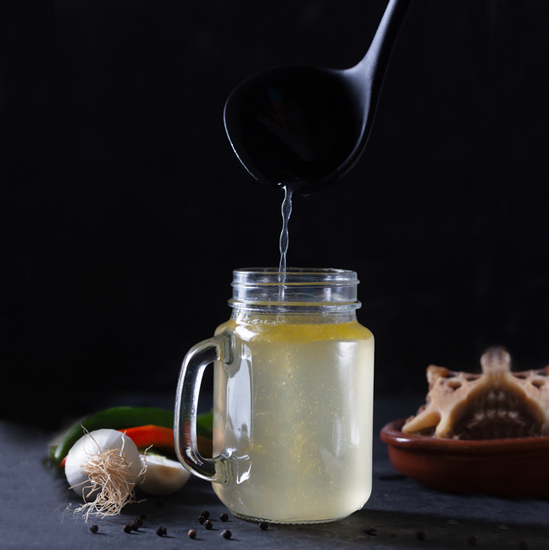 How to Make the Best Bone Broth
How to Make the Best Bone Broth
Studies show that you can maximize the collagen content of broth by starting with collagen-rich bones (think marrow bones, chicken feet, and trotters) and simmering until the bones are soft and crumble easily in your hand, about 24 to 48 hours for smaller bones like chicken bones and 72 hours for bigger beef bones. See Gelatin vs Collagen vs Bone Broth. Adding vinegar doesn’t actually make much of a difference, so flavor preference should be the deciding factor on that one.
Here is my recipe for Chicken Bone Broth and you can find more broth recipes in all of my cookbooks, but you don’t really need a recipe.
- You can use raw bones or the bones from cooked meats. Pro tip: I save all the bones from bone-in meat cuts like roasts or whole chicken that I made and add them to a container in my freezer. When I have enough for a full stockpot of broth, I make a batch!
- Add the bones to a stock pot, fill with water to about an inch or two over the top of the bones (add a splash of vinegar if you want to), bring water to a boil, and then cover and reduce heat to maintain a low simmer.
- If you’re using feet, boil for ten minutes, then dump out the water, check the blanched feet for any dirt that might need to be cleaned away, then refill the stockpot and bring back to a boil. (You can skip this step if your butcher or farmer pre-blanched the feet you’re using.) If you’re using raw bones other than feet, skim any foam that forms at the top during the first twenty minutes or so (if you skip this step, the broth will be a bit more bitter, not the end of the world.)
- Stir every once in a while, say every 4 or 6 hours (but don’t worry about stirring overnight), which gives you a chance to make sure the water level isn’t getting too low (if so, top up and reduce the heat a little) and check on the bones to see if they’re getting brittle yet. Fish stock only takes about 4 hours total, chicken is best when simmered around 24 to 30 hours, and beef, pork or lamb are best simmered for at least 48 hours. Pro tip: These times are for stovetop. If you’re using a pressure cooker, divide the time by 4 (you get about the same quality broth after 6 hours in a pressure cooker compared to 24 hours on the stovetop), and if you’re using a slow cooker, multiply the time by 4 (you get about the same quality broth after 4 days in a slow cooker compared to 24 hours on the stovetop).
- Once the bones are crumbly, add your aromatics (onions, carrots, celery, garlic, bay leaf, rosemary, thyme, etc.) if desired and simmer for 1 to 2 more hours. You can completely skip this step for a straightforward bone broth. (And make sure to skip the alliums if you’re going to give broth to a pet!) Pro tip: You can also save the ends of carrots, celery, onions and even fresh herbs and throw them into a bag in the freezer and save them to flavor your broth at this step. Yes, you can even put the papery outer layer of the onion and garlic into your broth because you’re going to strain these out and discard them!
- Strain your broth. Pro tip: I make my broth in a large stock pot with a pasta insert. When it comes time to strain my broth, all I need to do is lift out the pasta insert and let it drain! Of course, any strainer or sieve will do the job, too.
- If you want to concentrate your broth for a higher collagen content, you can raise the heat to a rapid simmer and simmer with the lid off until your broth has reduced by half or more. Totally optional step, but worthwhile if a rich broth is the desired outcome! Great for a more unctuous mouthfeel (and shoutout to my co-host on The Whole View, Stacy Toth, for teaching me the word unctuous!).
- Depending on how you’re going to use your broth, you can season it at this point by adding salt a bit at a time, stirring and tasting, stopping when it’s delicious; or you can keep your broth unseasoned for more versatile uses.
- Voila! High quality homemade bone broth achieved!
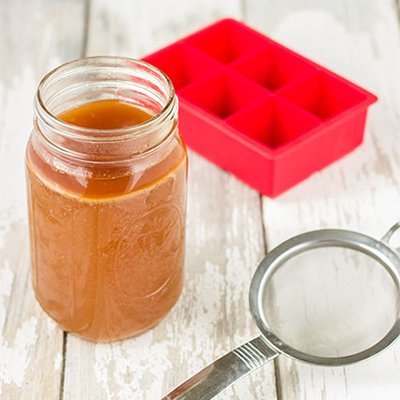 I make big batches of long-simmered broth and freeze whatever I’m not going to cook with imminently in wide-mouth mason jars, which makes later defrosting easy peasy. I really only sip a mug of broth if I’m feeling under the weather and instead prefer to add broth to all kinds of recipes, not just soups and stews, including making rice, mashed veggies, stir fries, hashes, and braising. You can also get super creative: add broth to a smoothie, mix with juice or whole fruit puree for popsicles, or replace the milk or water in a muffin recipe with broth (you’ll want unseasoned broth for all of these applications).
I make big batches of long-simmered broth and freeze whatever I’m not going to cook with imminently in wide-mouth mason jars, which makes later defrosting easy peasy. I really only sip a mug of broth if I’m feeling under the weather and instead prefer to add broth to all kinds of recipes, not just soups and stews, including making rice, mashed veggies, stir fries, hashes, and braising. You can also get super creative: add broth to a smoothie, mix with juice or whole fruit puree for popsicles, or replace the milk or water in a muffin recipe with broth (you’ll want unseasoned broth for all of these applications).
Note: How much a broth gels when chilled is a function of its collagen concentration in addition to how hydrolyzed the collagen is. Long-simmering, while awesome for extracting more collagen out of your bones, will also hydrolyze your collagen so it won’t gel as well, and that’s totally fine! All the good stuff is still there! If you want your broth to gel more, start with collagen-rich bones (chicken feet or fish heads will gel the best), simmer on the shorter end of time (that magic window between extracting as much collagen from the bones as possible but before too much collagen hydrolyzes), and pack as much bones into as little water as possible (alternately or in addition, you can reduce your broth at the end). It is possible to get a broth so rich it gels like an aspic this way!
Of course, there’s lots more tips and tricks to make a super flavorful and collagen-rich broth in episodes 98 and 313 of The Whole View Podcast, where Stacy and I answer all your questions about cooking your broth, from getting it to gel, to how many bones and what kind to use, what to do if you hate the smell, as well as cooking lengths and tips for flavoring your broth. Listen here:
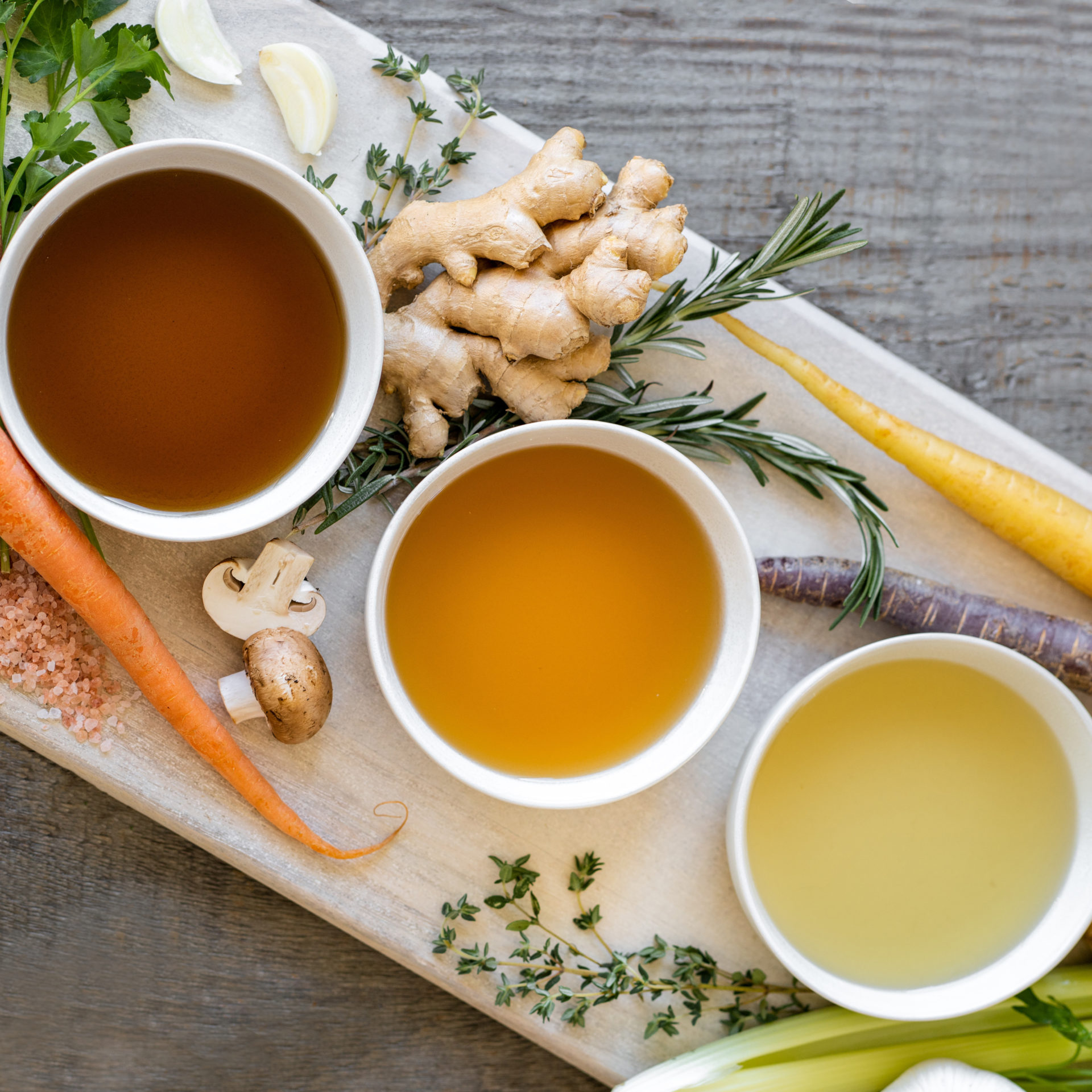 How Much Broth?
How Much Broth?
Most studies showing measurable health benefit of collagen used doses between 10 and 20 grams daily, which is equivalent to about 1/2 to 1 cup of good quality bone broth per day.
However, you can consume quite a lot more than that without jeopardizing the amino acid balance of your diet as a whole. Researchers have calculated that collagen can make up to 36% of our dietary protein while ensuring indispensable amino acid requirements are met. That means that if you’re aiming for 150 grams of protein daily, you can safely get a little over 50 grams of that from collagen! Soup for every meal! See Gelatin vs Collagen vs Bone Broth.
My Recommendations to Keep it Simple
And, of course, I also turn to Kettle & Fire Bone Broth to make the process of getting in this superfood a whole lot easier. It’s shelf-stable, yet contains all the nutrients and flavor of traditionally-made broth. I keep a few boxes of their beef bone broth in my pantry at all times, so I can fast-track my way to a delicious meal or mug even at the busiest of times! (Note for my AIP readers, the beef broth from Kettle & Fire does contain black pepper.) You can save 15% off with coupon code PALEOMOM here.
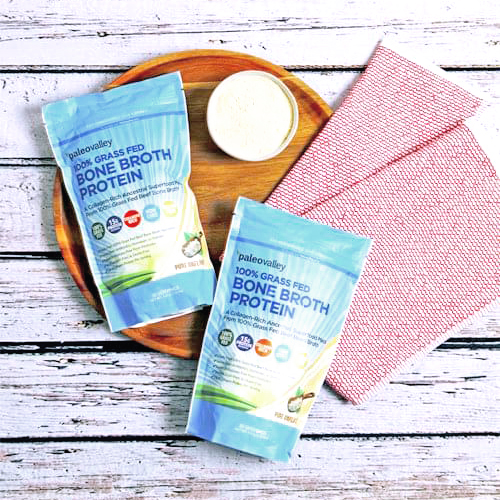 Another awesome source of bone broth that I rely on is Paleovalley 100% Grass-Fed Bone Broth Protein, which is made by slow-simmering 100% grass-fed beef bones in filtered water, just like I would at home, then it’s gently powdered with no additives. It’s never treated with chemicals or high-heat, and it’s third-party tested for contaminants. I add a scoop of Paleovalley Bone Broth Protein to my morning coffee every day, and I also add it to smoothies, soups, stews, stir fries and even baking. It has very little flavor (I can’t taste it at all in my coffee), but you can turn it into a warm cup of broth with it by mixing into hot water and adding salt to taste.
Another awesome source of bone broth that I rely on is Paleovalley 100% Grass-Fed Bone Broth Protein, which is made by slow-simmering 100% grass-fed beef bones in filtered water, just like I would at home, then it’s gently powdered with no additives. It’s never treated with chemicals or high-heat, and it’s third-party tested for contaminants. I add a scoop of Paleovalley Bone Broth Protein to my morning coffee every day, and I also add it to smoothies, soups, stews, stir fries and even baking. It has very little flavor (I can’t taste it at all in my coffee), but you can turn it into a warm cup of broth with it by mixing into hot water and adding salt to taste.
Whether you make it yourself or keep it easy with Kettle & Fire or Paleovalley, bone broth is an awesome superfood that we can all benefit from including in our diets on a regular basis! You know the old aphorism is “A cup of broth a day keeps the doctor away”. Wait, that’s not how it goes? Well, it should be!














